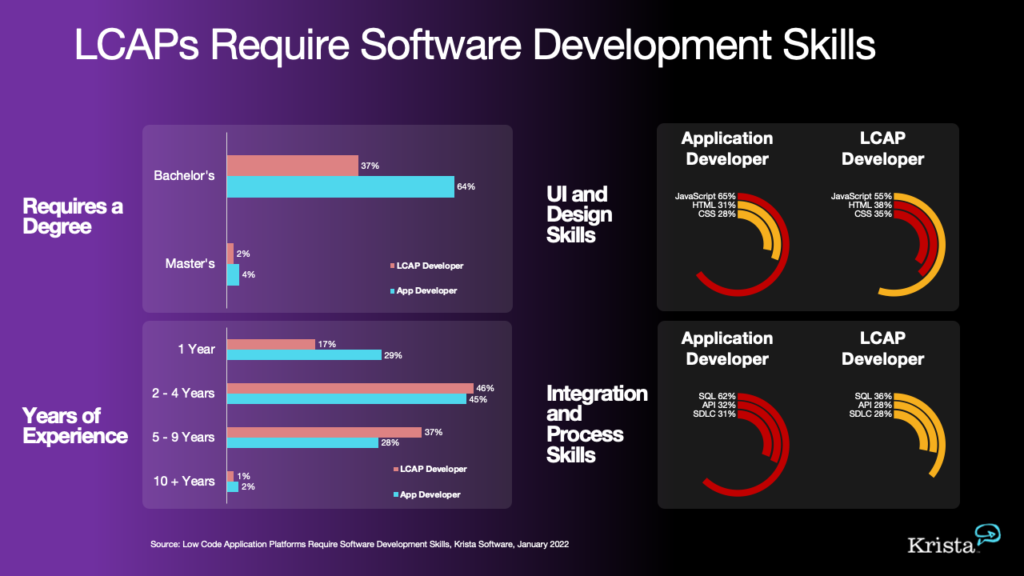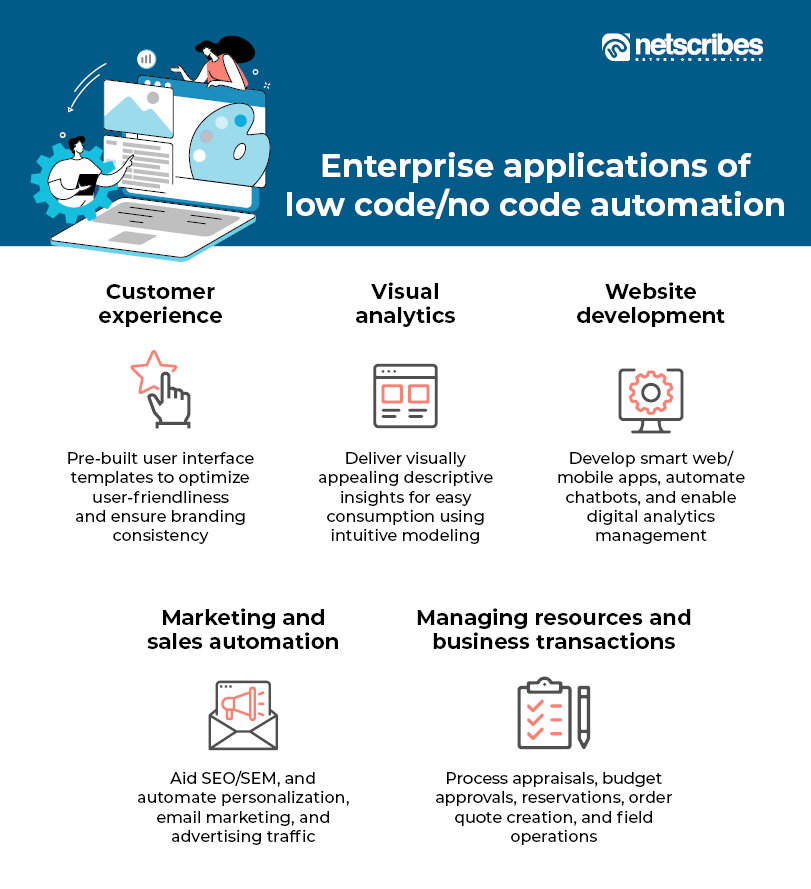Top Info For Selecting Low-Code Platform Recommendations
Top Info For Selecting Low-Code Platform Recommendations
Blog Article
App Development Using Low-Code Is More Efficient.
Visual Development Environment:
Drag-and-Drop Interfaces: Low-code platforms provide visual tools for designing applications. Drag-and-drop elements enable developers to rapidly build applications without writing long lines of code.
Many low-code platforms have pre-built templates and components. This allows developers to quickly prototype or build applications, without having start with a blank slate.
Coding Requirements Reduced
Automated Coding Generation Low-code platforms generate the code automatically using the visual model designed by developers. This eliminates the need to manually code and improves the speed of development.
Reusable components: Developers can to use reusable component across multiple projects, which can reduce the amount of time they spend writing and testing code.
Collaboration can be made easier.
Integration of Development Tools: Low-code tools usually contain tools for managing versions, testing, and deployment which facilitates seamless collaboration between development teams.
Citizen Development (Citizen Development): Users and non-developers of business applications are able to participate in application development making use of intuitive interfaces. This can help reduce the bottleneck created by limited accessibility of professional developers.
Rapid prototyping, rapid iteration and rapid prototyping
Rapid Prototyping Developers can swiftly build prototypes for ideas to be evaluated and feedback collected and analyzed, which leads to faster iterations.
Simple modifications. The visual interface low-code development provides allows users to easily update and change applications. This speed up the process of improving and refining the application by incorporating user feedback.
Pre-built Integrations:
API Integrations: Low-code platforms typically include pre-built connectors to popular services and APIs making it easier to integrate external systems.
Data Integration: Inbuilt software for data integration make it easier to process of connecting to databases and other sources of data and speeding development.
Scaling deployment:
One-Click Installation: Many low-code platforms provide the option of installing with one click that reduces the amount of work and time required to install software.
Cloud-based solutions: Cloud-based low-code platforms can manage scaling and infrastructure management, allowing developers to focus on application logic and functionality rather than deployment logistics.
The overall efficiency of developing low-code applications is in its ability to simplify and automate many aspects of the app development. This allows for faster development of apps as well as quicker adaptation to the changing demands. Take a look at the recommended view website about Low-code Platform for application development for site tips including push notifications android, driver jdbc, low code platforms, cross platform app dev, application modernisation, application development platforms, multiplatform mobile app development, rad application development, rapid action development, application modernization and more.
Benefits Of Developing Applications Using Low-Code In Terms Of Cost-Effectiveness
Low-code applications offer a variety of advantages in terms of cost-effectiveness. Businesses looking to optimize budgets can benefit from this method while still delivering high-quality applications. The main advantages:
A Less Code Required Low-code platforms eliminate the need for extensive hand-coding, reducing the amount of time and effort developers have to put into developing applications. This results in less labor costs.
We have fewer resources available for developers: Low-code programming is easier and faster and therefore fewer developers with specialized skills are required. This will significantly cut down on costs for hiring and staffing.
Faster Time to Market:
Accelerated Development Cycle: Low-code platform visual tools and components enable rapid development of applications, which allows businesses to launch products more quickly. This may result in quicker revenue generation, and improved position in the marketplace.
Rapid Prototyping - Businesses can develop and test prototypes within a short period of time, which reduces the amount of time required for the development phase. This allows them to create faster prototypes after receiving feedback from users.
Lower maintenance costs:
Because of their modular design and standardised components, low-code platforms usually make it easier to maintain applications. This lowers the costs of ongoing maintenance.
Automated updates: A lot of low code platforms automatically handle updates and patches, ensuring that applications are secure and up to date without the need for extensive manual intervention.
Efficient Resource Utilization:
Contributions from non-developers: Low code platforms enable non-developers for example, business users to be a part of the process of development. This makes it possible for companies to benefit from the skillsets of a wide spectrum of employees.
Optimized Use of IT Resources: IT departments are able to focus on more strategic endeavors instead of being slammed by routine tasks of development increasing overall efficiency and productivity.
The Scalable Pricing models
Subscription-Based Pricing: A lot of low code platforms offer an affordable subscription-based pricing model that grows according to usage. This lets businesses align their spending with their actual needs and increase their revenue, without incurring large upfront expenses.
Pay-Assosiated Options: Some platforms offer pay-assosiated alternatives. They ensure that businesses pay only for the resources used which is advantageous to entrepreneurs and small businesses that have limited resources.
Reduced costs of third-party software:
Built-In Functionalities: Low-code platforms often come with built-in functionalities and integrations that minimize the requirement for third-party software and tools which results in savings on licensing fees and subscription costs.
Pre-Built Intergrations: The ability to use pre-built integrations and pre-built integrations with popular applications and systems reduces the need for custom development, and helps save time and money.
Better ROI
A faster return on investment: The combination of speedy development and lower costs, coupled with an increased time to market will allow businesses to earn greater return on investment.
Improved Agility. Businesses can quickly adapt changing market conditions and requirements of customers and ensure that they remain relevant. They also can profit from new business opportunities when they come up.
Costs of training are lower:
User-Friendly Interfaces: Low code platforms provide intuitive and simple-to-use interfaces, which decreases the learning curve.
Accessible Resources: A lot of platforms that make use of low-code have comprehensive instructional materials, tutorials, as well as community support. This means that there is less requirement for formal education as well as the expenses associated with it.
Collaboration Streamlined:
Enhanced Collaboration Tool: The built-in collaboration tool helps improve collaboration and communication between team members. This leads to more efficient development processes, and also reduces the cost of projects.
Unified Development Environment: A single integrated development environment helps streamline workflows and reduces the difficulties and expenses associated with managing multiple platforms and tools.
The cost-effectiveness in low-code app development lies in its ability to reduce development and maintainance costs, speed up the time to market, maximize resources, and provide flexible pricing models. The combination of these factors can provide companies significant financial advantages which makes Low-code a desirable option for businesses looking to increase their development budgets while still achieving robust and scalable applications. Check out the best on the main page for website tips including microsoft azure sql, rad application development, cross platform app development, microsoft azure sql, mobile app development platforms, application modernization, rapid app development, low code platforms, azure sql, mobile development platforms and more.
The Benefits Of Low-Code Development For Both Community And Vendor
Low-code development platforms for applications can be an excellent method to gain vendor support and community involvement. Both are essential to ensure a successful implementation and ongoing maintenance of the application. Support from the Vendor
Comprehensive Technical Support:
Support Teams: Many Low-Code platforms provide access an experienced support team that assist with technical issues, advice and troubleshooting.
Certain vendors offer support 24 hours a day. This can be very advantageous for companies operating in different time zones.
Training and Onboarding
Structured Training Programs: Vendors often offer structured training courses which include webinars, tutorials and courses for certification, to assist users in getting up to speed quickly.
Personalized onboarding: Many vendors have personalized services for new customers, to help them implement the platform in a proper manner and customize it to meet their requirements.
Regular Updates, Enhancements, and Improvements:
Continuous Improvement: Low code platform providers provide regular updates that include new features, security patches, and enhancements to performance. This helps ensure that the platform is always up-to-date and secure.
Feedback Integration: Vendors frequently include feedback from users into their development cycles, ensuring that their platform is constantly evolving to meet the changing needs of its users.
Comprehensive Documentation:
Documentation: Comprehensive documentation is available for most products. It covers everything from the basics to advanced customization. This can help users find solutions for themselves.
API References In-depth API documentation allows developers to customize applications and integrate low-code platforms with other platforms.
Consulting and Professional Services
Expert Consulting: A lot of companies offer consulting services to help users with complex implementations and designs for architecture and strategic planning.
Custom Development Services - Certain vendors provide customized development services for specific capabilities or integrations that are not offered out of the standard version.
Community Support
Active User Communities
Forums and Discussion Boards: Numerous low-code platforms have lively online communities that allow users to discuss issues, ask questions, and share solutions, and share best practices.
Local and Virtual User Groups and Meetups, provide opportunities for users to exchange experiences, learn from others, and network.
Collaboration and knowledge sharing:
Community-Contributed Resources: Users often share templates, modules, and extensions that they have developed, which can be reused or adapted by others, accelerating development and innovation.
Crowdsourced Solutions: The collective knowledge, experience and expertise of a community may prove to be a useful tool in troubleshooting and finding creative solutions.
Learning and Development:
Community-Led Learning: Many communities host training sessions, workshops and webinars which are typically run by experienced users who can share their knowledge and techniques that are more advanced.
Online Tutorials and Courses The community members develop and publish tutorials, online courses and guides on how to use. This improves the educational resources accessible to all users.
Feedback and Influence
Community Forums are typically an opportunity for vendors to receive feedback from the community. This information can be used to develop new features or improvements.
Beta Testing Programs: Members of the community who are active could be able to be part of beta testing programs that give them early access to new features as well as a say in shaping the platform's evolution.
Recognition and Encouragement
Community Recognition Programs: Many vendors have recognition programs to honor the efforts of active community members like MVP (Most Valuable Professional) programs.
Support from peers: Community members tend to be willing to provide peer-support, offering their expertise and assistance to those who may be less familiar. They help create a supportive environment by fostering collaboration and a supportive atmosphere.
Overall the combination of strong vendor support and a vibrant, engaged community provides an extensive support system for development of low-code applications. The combination of robust vendor support and an active and active community offers an extensive support system for development of low-code applications.